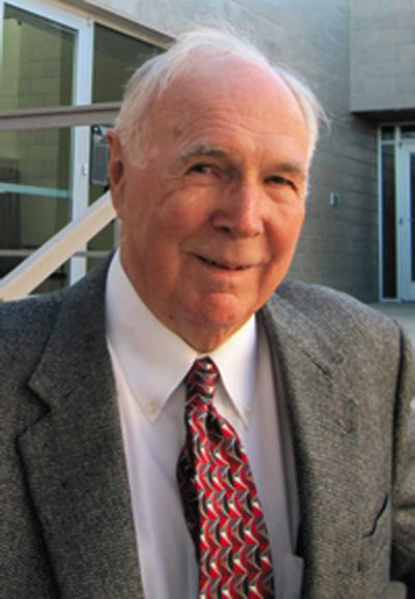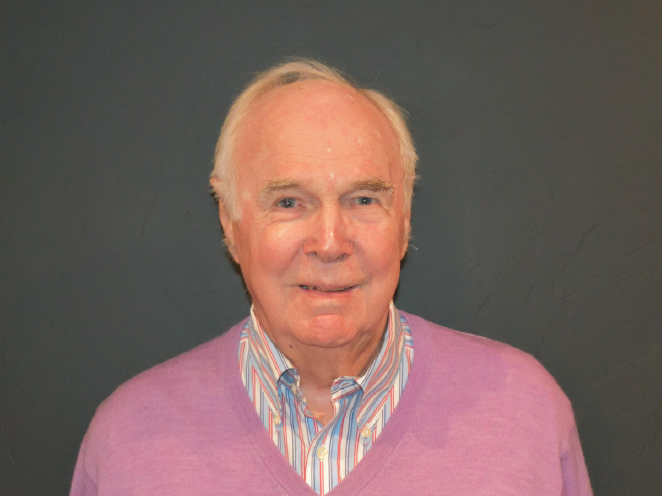HAROLD W. PAXTON
1927–2021
Elected in 1978
“Contributions to metal science and application of this understanding to the improvement of metals and their processing.”
BY ALAN W. CRAMB
HAROLD WILLIAM PAXTON, US Steel Professor Emeritus in the Department of Materials Science and Engineering at Carnegie Mellon University, was a noted physical metallurgist who shaped the future of metal science, steel production and its application, and engineering education. He died March 8, 2021, at the age of 94.
Known to everyone as Harry, he was not only a well-respected, world-leading metallurgist but also an outstanding organizational leader in industry, universities, government agencies, and nonprofits. He was well known for his wry sense of humor, his ability to solve difficult problems in novel ways, and his love of golf.
Hilda and Jack Paxton announced the birth of Harry on February 6, 1927, in Goldsboro, Yorkshire, England. Twenty years later he earned his bachelor’s (1947) and master’s (1948) degrees in metallurgy from the University of Manchester and, after spending a year on scholarship at Carnegie Tech in Pittsburgh, got his PhD (1952) from the University of Birmingham, where he met and married Ann Dorothy Davies. In 1953 they moved to the United States when he accepted a position at Carnegie Tech (now Carnegie Mellon University) as an assistant professor in the Metallurgy Department, teaching a course on alloy steels.
He became department head and director of the Metals Research Laboratory in 1966.
With the exception of a few stints away from the campus, Carnegie Mellon was Harry’s professional home. He was a visiting professor at Imperial College London in 1962 and at the Massachusetts Institute of Technology in 1970. He left CMU briefly (1971–73) to become the first director of the Materials Division of the National Science Foundation (NSF), and again in 1975 when US Steel hired him as vice president of research. After retiring from US Steel as vice president of corporate research and technology assessment in 1986, he returned to CMU as the US Steel Professor in the Department of Materials Science and Engineering until his retirement in 1996.
In addition to his work in the development of alloy steels—his most significant contribution to metals science—he coauthored the book Alloying Elements in Steel (American Society for Metals, 1966) with Edgar C. Bain (NAS) of US Steel.
He was also active on committees of the National Academies of Sciences, Engineering, and Medicine. He was appointed to the Committee on the Competitiveness of the Minerals and Metals Industries (1988–90), Committee to Review the Ohio Thomas Edison Technology Centers (chair; 1989–91), Committee on Research Programs of the US Bureau of Mines (1994–96), and Committee on Materials Technologies for Process Industries (1999–2001). In his capacity as an NAE member, he served on the Materials Engineering Peer Committee (1987–89), Awards Committee (1986–87; chair, 1987–88; and 1988–89), and Committee on Membership (1991–94).
His technical and educational contributions were well recognized. He received the ASM Bradley Stoughton Award for Young Teachers of Metallurgy in 1960. In 1978, besides his NAE election, he was selected as the ASM Edward DeMille Campbell Memorial Lecturer. In 1983 he gave the ASM Zay Jeffries Lecture and received the ASM Gold Medal for the Advancement of Research. In 1985 he was designated an honorary member of the Iron and Steel Institute of Japan and delivered its Yukawa Memorial Lecture, and in 1987 he gave
the Harold Moore Lecture to the Institute of Metals (London). He also lectured in Argentina, Brazil, China, France, Holland, Mexico, Poland, the United Kingdom, and the former USSR.
He was president of the American Society for Metals and Minerals (ASM) in 1976 and president (1982) and honorary member (1991) of the American Institute of Mining, Metallurgical, and Petroleum Engineers (AIME). He was a fellow of the American Association for the Advancement of Science, ASM, and TMS (the Minerals, Metals & Materials Society, which became a separate entity from ASM in 1986).
As previously noted, Harry loved golf, and he was very involved in the Oakmont Country Club, where his putting prowess was often challenged. It was on the golf course that his humor and competitiveness were at their best. He always had an amusing story about the club members or about a time when he played with a famous industry or government leader. However, on serious topics it became clear that Harry thought deeply about the future for materials, for education, and, in particular, for Carnegie Mellon University, which was his professional passion.
His personal passion was, of course, his family, of whom he was very proud. His wife Ann was an accomplished artist, and during their 67 years of marriage she was also his companion, muse, and golf partner. In 1996 they moved to Green Valley, Arizona, where Harry got involved with the Community Performance and Art Center and became its chair in 2009.
Ann survives him, as do their four children—Jane Wasilov (Alex), Sally Paxton, Anthony Paxton (Lisa), and Nigel Paxton (Sue)—and six grandchildren.
Harry’s was a life well lived. He recorded an oral history for AIME 1; for anyone who wishes to better understand the man, in his own words, there can be no better way to spend an hour.
__________________
1 Available at https://aimehq.org/what-we-do/oral-histories/harold-w-paxton.






